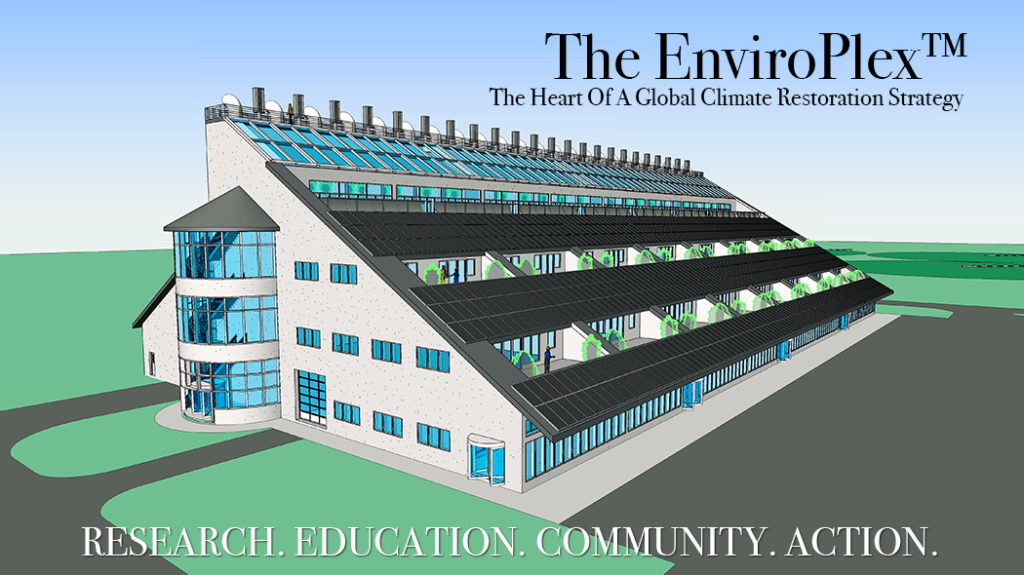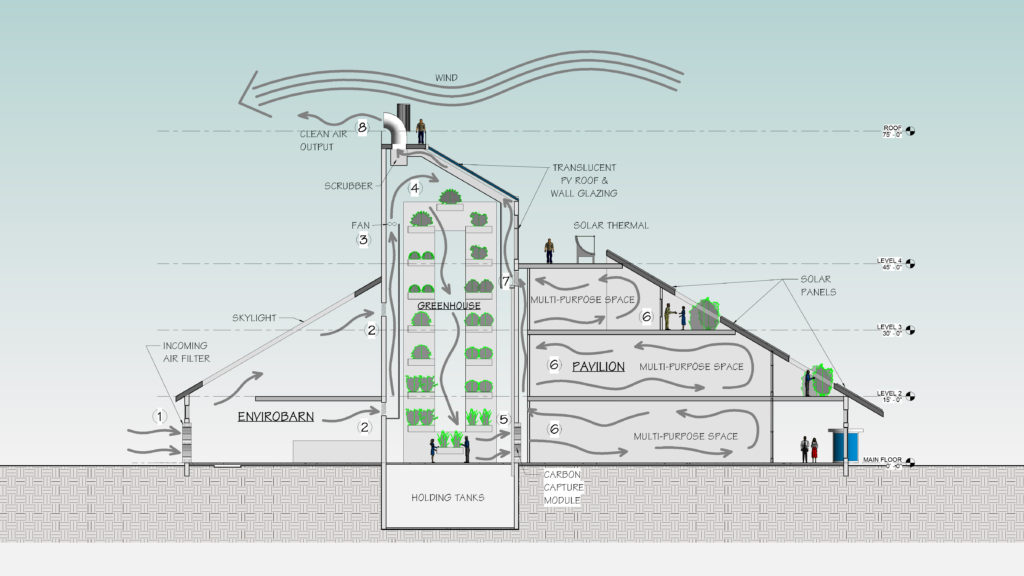A Mass-Producible
Climate Restoration Solution

The EnviroPlex™ is a multi-purpose, modular, high-tech installation combining organic food production and pollution-free energy generation with direct-air carbon capture and sequestration. It is a one-acre (45,000 sq ft) carbon-negative mass-producible building with three main components: Barn/Factory/Market, Greenhouse/Vertical Farm and Multi-Use Pavilion. It runs on renewable energy: sun, wind, water, geothermal, etc. It can even be radiation-proof. Watch the 1-minute video below, then return here for much more.
- The EnviroPlex™ captures CO2 from the atmosphere using a combination of photosynthesis and the proprietary mass-produced Carbon Capture Module™.
- It filters out gaseous air pollutants (nitrogen and sulphur oxides, ammonia, carbon monoxide, etc) and airborne particulate matter such as coal and wood smoke, smog, exhaust fumes, diesel soot and other PM2.5 materials.
- It’s an organic farm and farmers’ market. Using photosynthesis, it converts captured CO2 into healthy vegetable produce for human and animal consumption.
- It chemically removes atmospheric CO2 by converting it to a climate-safe water-soluble compound, which can then be converted to valuable derivative products such as soil additives, building materials, fuels, and carbon-fiber composite materials for 3D printing.
- It’s a factory and research laboratory, developing marketable derivative products from the captured carbon.
- It improves the living conditions of occupants and workers.
- It provides employment for local community members.
- In hot, dry weather, at no additional cost, it provides evaporative cooling, a climate-friendly alternative to air-conditioning.
- In addition to the farm-related components, each EnviroPlex™ provides a healthy 22,500 sq.ft. clean-air indoor refuge which the owner/developer/community can utilize in a multitude of economically-valuable ways: shopping mall, convention center, college campus, business complex, light industry, corporate headquarters, elder care, hospital, residential, etc.

Each EnviroPlex™ is a one-acre, 45,000 sq. ft (150ft X 300ft) installation divided into four (4) equal modules of 75 ft by 150 ft and containing a total of twenty four (24) Carbon Capture Modules™.
*Note:
1. These architectural renderings were created for Sacred Earth Enterprises dba Circular City Consulting, LLC by James Plagmann, AIA, HumaNatureArchitecture, Boulder Colorado.
2. The inventions, designs and trade names Carbon Capture Module™, CCM™ and EnviroPlex™ are globally IP protected by blockchain-based Time Stamped Authority (TSA) certificates.
Energy Usage
The EnviroPlex™ is a carbon-negative building. It runs as much as possible on renewable energy. It is designed to generate additional electricity for the surrounding community. It can offer parking and charging stations for electric vehicles, the batteries of which could provide overnight storage for the excess PV electricity generated by the installation during the day.
Note the multiple wind turbines at the peak of the building. When a strong wind is blowing, it is possible that the EnviroPlex™ will operate on direct wind power, reducing the electrical energy usage of the Carbon Capture Modules™ to zero.
Competition
A viable climate solution must have a low embodied energy level. Most of the carbon dioxide removal (CDR) proposals currently in development are too expensive and energy intensive to be effective. Many are commercial operations designed to capture and market carbon products for profit. They look like factories, because…they are factories. The CO2 they capture will return to the atmosphere though combustion or off-gassing, with little net effect on global warming.
Our installations, on the other hand, are aesthetically-pleasing.** They are designed to remove large amounts of CO2 from the atmosphere permanently, and to do something environmentally and economically beneficial with the captured carbon. The installations operate on renewable energy and are net energy producers. They also provide multiple social, health and economic benefits to the community, unlike other proposals on the table.
**Note that the architectural renderings in this presentation represent only one of an unlimited number of possible designs.
Primary Functions
- Atmospheric pollutant and carbon dioxide removal (CDR) using a simple chemical engineering process: the proprietary Carbon Capture Module™.
- Organic food production and agricultural greenhouse gas (GHG) emissions reduction.
Beijing and Shanghai
This proposal was originally developed for a series of installations around the Chinese cities of Beijing and Shanghai, but it can be re-purposed for virtually any location. Beijing and Shanghai suffer from extreme atmospheric pollution and contribute significantly to the global warming crisis. They also have enormous populations to feed. The EnviroPlex™ addresses these challenges in a climate-friendly, carbon-negative, sustainable, socially and economically beneficial manner.
Seasonal Adaptability
There are numerous variables to consider when planning a specific installation: scale, location, weather (temperature extremes, humidity, prevailing winds,) desired outcome, aesthetics and budget. Shanghai and Beijing have large seasonal variations in temperature and humidity, requiring that the EnviroPlex™ installations be seasonally adaptable.
Functions, Modules, Airflow
The one-acre EnviroPlex™ building is composed of three separate but connected modules: the Barn/Factory/Market, the Greenhouse/Vertical Farm and the Multi-Use Pavilion.
Module 1. The Barn/Factory/Market: Polluted outside air is drawn into the complex through the north-facing Barn/Factory/Market where it undergoes its initial cleansing. Gaseous pollutants (nitrous oxide, ammonia, sulphur dioxide, carbon monoxide, etc) and airborne particulate matter such as coal and wood smoke, smog, diesel soot and other PM2.5 materials are removed, providing improved health and working conditions for the customers and the workers in the Barn/Factory/Market and the Greenhouse. CO2 is not captured at this stage.
Module 2. The Greenhouse/Vertical Farm/Light-Well separates and connects the outer two modules. Clean air passes from the Barn to the Greenhouse, which uses photosynthesis and the CO2 enhanced output of the Barn/Market to grow organic produce, before carbon-reduced, oxygen-enhanced air is passed to the Multi-Use Pavilion via the Carbon Capture Modules™.
The unused CO2 leaving the Greenhouse/Vertical Farm is chemically captured as a neutral, harmless aqueous solution as it passes through the Carbon Capture Modules™. The captured CO2 is sequestered in an underground holding tank prior to passing through the rooftop solar furnaces for water recovery and concentration for future commercial applications. (See Phase II for specifics.)

Module 3. The Multi-Use Pavilion is a light-filled, airy, 22,500 sq. ft. multi-story clean-air building which provides a climate-controlled refuge from the polluted outside environment. The clean, low-carbon air from the Pavilion undergoes a final scrubbing before being released via downwind-facing powered extractor vents at the peak of the facility, cleansing the surrounding outside atmosphere.
The Carbon Capture Module (CCM™)
SUMMARY:
To restore our climate to pre-industrial conditions, technologies such as these must be deployed at “military” scale. Climate scientists agree that CO2 removal using hundreds of thousands of CCM™ arrays or similar carbon capture systems is an essential component of an effective climate restoration strategy. See the April 2018 RAND Corporation Report.

A 16-unit CCM™ Wall Array 36 ft. wide by 9ft high.
- Arrays of CCM™s clean and filter polluted air, removing particulate matter (PM2.5), oxides of nitrogen and sulphur, ammonia and other toxic pollutants, as well as atmospheric CO2.
- Installed in sufficient numbers, CCM™ arrays reduce and reverse global warming.
- CCM™s capture gaseous CO2 for the Greenhouse/Vertical Farm, as well as other useful, marketable carbon compounds.
- These compounds can be converted to valuable derivative products, such as soil additives, building materials, fuels, and carbon-fiber composite materials for 3D printing.
- Second generation 3D printed carbon-fiber CCM™s will become self-replicating using artificial intelligence, beginning with the fans that move the air. Carbon-fiber fan blades use 70% less energy than aluminum ones.
- CCM™s run on cheap, common chemicals, recycled water (including river and ocean water) and renewable electrical energy (sun, wind, geothermal etc.) The water is desalinated, recovered, purified and recycled.
- CCM™s can provide cool, clean, moist interior air in hot dry climates like the American Southwest, the Middle East and much of India, China, Africa and Australia.
- CCM™s provide a sustainable, affordable alternative to air conditioning in such climates.
- The CCM™ is modular, which means that CCM™ arrays can be mass-produced and CCM™- based installations scaled without limitation.
- CCM™s can be configured into aesthetically-pleasing lightweight structural wall components for enclosed spaces: desert oases, urban parks, gardens, residential buildings, hotels, greenhouses, factories, warehouses, sports arenas and so on.
- The CCM™ is based upon simple chemistry and physics that every high school student should understand.
- The CCM™ represents a very large manufacturing and marketing opportunity. Industrial-scale CCM™ installations will create significant return on investment.
- Multiple spin-off industries will evolve from the carbon-based byproducts generated.
- These clean, eco-friendly new businesses will produce industrial tycoons of the future.
Conclusion
EnviroPlex™ and other CCM™ installations can contribute to the restoration of a healthy global climate while generating significant return on investment. They can sequester millions of tons of carbon dioxide annually, garnering 45Q tax credits of at least $35/ton in the USA. They can reduce agricultural greenhouse gas emissions, purify local air and water, provide significant economic, health and social benefits to the community, and, installed in sufficient numbers, reduce and reverse global warming.

© 2017 Andrew C. Bailey/ Circular City Consulting, LLC.
All rights reserved.
eMail: acb@circularcity.us
